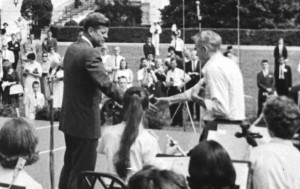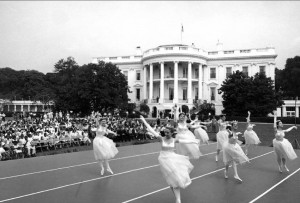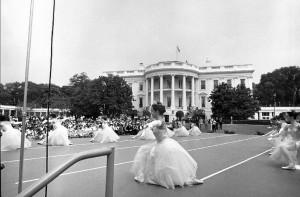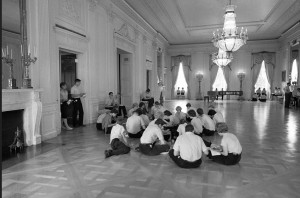Remembering Pianist Van Cliburn
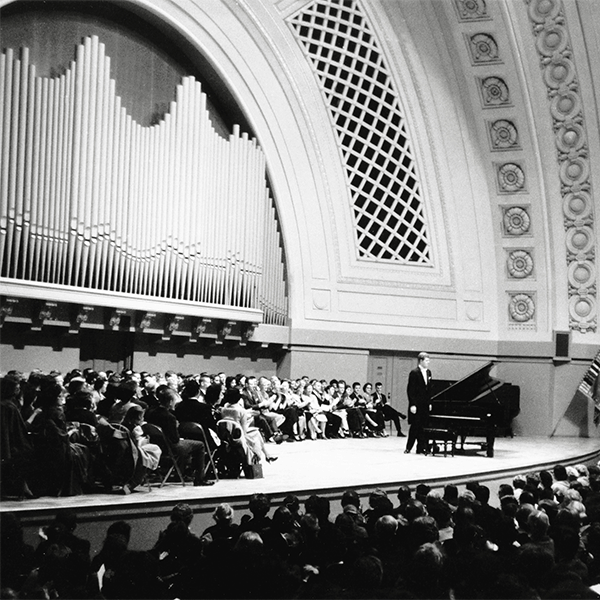
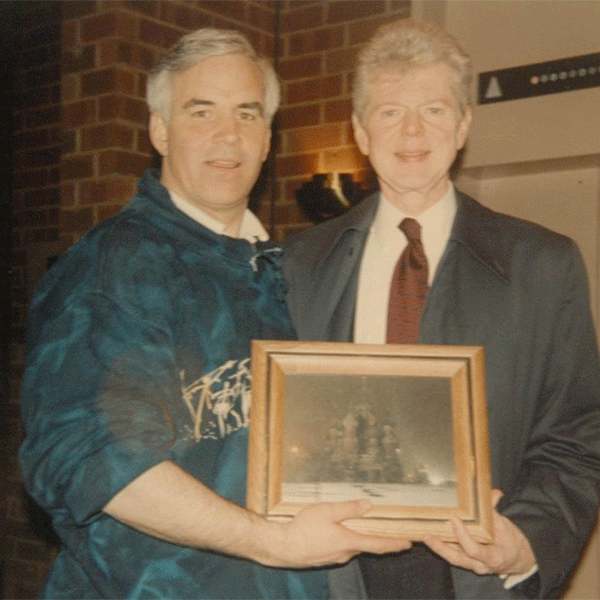
Photos: L: Van Cliburn performs for a capacity audience including “stage seating” in Hill Auditorium in March 15, 1968. R: UMS president Ken Fischer with Van Cliburn during his visit to Ann Arbor for the first Ford Honors Program in 1996.
When Penny and I were teens at Interlochen in 1961, we had the thrill of accompanying this ‘rock star’ of classical music as members of the National High School Orchestra when he performed the Tchaikovksy piano concerto in the Kresge Auditorium at Interlochen. It was this piece that sealed his winning the first Tchaikovsky competition in Russian in 1958 at the height of the Cold War between Russia and the U.S.
I served on the Interlochen board with Van in the early 1970s. He maintained a long relationship with Interlochen for many years and provided scholarship support to many students.
He received the UMS Distinguished Artist Award at the inaugural Ford Honors Program on May 11, 1996. The photo above was taken of Van and me outside of Sloan Plaza in Ann Arbor where Van stayed in the apartment provided by Don Chisholm. I gave him a photo I had taken the previous November when I was in Moscow’s Red Square. It’s a photo of St. Basil’s Cathedral taken in a snowstorm.
UMS commissioned Ann Arbor singer-songwriter Dave Barrett to produce a 4-minute video on Cliburn’s career that we showed at Ford Honors. Barrett set the video to the music of “One Shining Moment,” the famous sports song that Barrett wrote and that has accompanied the highlight film following CBS’s coverage of the NCAA National Championship basketball game for the past 27 years. The song has been performed by such artists as Luther Vandross, Teddy Pendergrass, Jennifer Hudson, and Barrett himself. It’s Barrett who performs it in the video.
Van Cliburn had “One Shining Moment” at the Tchaikovsky competition so it seemed appropriate to use this music with a few word changes as a backdrop to the video. The images in the video are from a 1996 documentary directed by Peter Rosen titled “Van Cliburn: Classical Pianist.”
I will remember Van as a warm, gracious person who loved people, loved the arts, and loved life.
The King’s Singers: Ken Fischer’s First Presentation

Photo: King’s Singers and Ken Fischer following their April, 1990 concert in Hill Auditorium.
Editor’s note: Ken Fischer first presented the King’s Singers at the Kennedy Center on Valentine’s Day 1983. They return to perform in Ann Arbor during Ken Fischer’s final season before retiring from UMS.
I first heard about the King’s Singers in 1981 from my brother, Jerry. He played me I’m a Train, New Day, Phyllis is My Only Joy, Georgia, The Long Day Closes, and scores of others. I was hooked. Wanting to share this new-found group with others in the Detroit area, Jerry and his presenting organization, Brethren Productions, brought the King’s Singers to Orchestra Hall in February of 1982. The concert was a big success.
I began to wonder, “If my brother Jerry can have success with these guys in recession-ridden Detroit, imagine what the Kings could do at the Kennedy Center.” They had never played “The Big House” before, and when I talked to two of the principal presenters in Washington about bringing these guys to the Kennedy Center, neither expressed interest.
So I decided to do it myself. Friends considered me a pretty good organizer, and I was making a living as an independent consultant helping organizations design their meetings and special events. I figured I could find some extra time to mount a Kennedy Center event, so in late February of 1982, I got in touch with the King’s Singers’ U.S. “agent-enthusiast” Beverly Taylor. Bev told me that the guys would indeed like to perform at the Kennedy Center and would be available during February of 1983.
“For you my friend, Mondays in February.”
I went to the Kennedy Center to see about booking the Concert Hall. I had never presented a concert like this before. When I sat down with the person that keeps the calendar, she greeted me with a look that seemed to say, “Now who the hell are you?” I was told that my priority for access to dates in the hall was about as low as you can get. “First comes the National Symphony Orchestra, then the Washington Performing Arts Society, and then the Choral Arts Society, then the…” She went on and on. I interrupted to ask, “Well what dates can I get?” And she replied, “For you my friend, Mondays in February. There’s the 7th, the 14th, the 21st, the…” I jumped up and said, “You mean the 14th of February is available! No one’s taken Valentine’s Day yet? Put me down!”
When I heard what the Kennedy Center would charge me, I took a deep breath. No way could I put up that kind of money. It was coming out of my own pocket, and I just didn’t have it. Then she said to me, “Look, instead of $10,000, why don’t you give me $2,500. That guarantees the hall rental, and that should be enough.” I called Bev Taylor later that day, and we struck a deal. The King’s Singers would perform in the 2,759-seat Kennedy Center Concert Hall on Monday, February 14, 1983.
I had arranged for the guys to arrive in Washington on February 2 for a pre-tour press conference. Washington’s professional football team, the Redskins, has just won the Super Bowl for the first time. When I picked the guys up from the airport, and I told them that if they followed my instructions they would have Washington in the palm of their hands. I handed each of them the sheet music for Hail to the Redskins, the fight song that everybody in Washington knows and loves. I urged them to learn this song and to incorporate it into their Press Club program. If they did so, I said, they’d be a big hit.
The guys sang beautifully and handled the interview superbly. Then it was time to wrap it up with two songs. They announced that they would sing: Rossini’s The Barber of Seville Overture, and the madrigal Now is the Month of Maying. I’m in shock. Don’t these guys know anything about marketing? Why don’t they listen to me? Then, instead of singing Now is the Month of Maying, they leap into Hail to the Redskins performed as a madrigal without missing a beat. The audience went wild.
Record-breaking snow
And then Monday, February 14 arrived, the day I’d been awaiting for a year. By midnight, Washington would receive a record breaking 29’’ of snow. Even at 8 am, everything was closed, and my day was just beginning. The guys would arrive in the late afternoon, and even more snow was expected. Oh, no.
At 3:15 pm, the guys and I walked to the Kennedy Center Concert Hall to begin our one-hour sound and light check. And, at 3:45 pm, while the guys were in the middle of rehearsing, the lights went out. All the lights. We learned that a transformer had blown nearby and that we were in the middle of a blackout.
The concert was scheduled for 8:30 pm. They informed me that they’ll do everything to put the show on, but if there is no power, there is no show. At 4:30 pm, the fellows return to their room at the Watergate, after walking up the ten flights of stairs (no elevators were running) to get ready for the show.
By 5:45 pm, the press had started to gather near the Kennedy Center, preparing for live broadcasts to report on the power failure. At 6:15 pm, we learned that the utility people were working on the problem. All of the other shows at the Kennedy Center that night had been canceled. All eyes were on me now. What was I going to do?
By 6:30 pm, word was out among the employees of the Kennedy Center that there’s this one guy holding everybody up from being able to go home early. And, at 6:41 pm exactly, just as we were about to cancel the concert, the lights come on. A team of volunteers and the media relations people announce that “while every other show at the Kennedy center is cancelled, the King’s Singers are still on.”
At 8:30 pm, our concert begins with 2,200 people in the hall. 200 of them had probably arrived at the Center with no intention of attending our concert, yet there they were. The other 2000 had made their way through snow-covered streets or had traveled great distances to be there. I loved every one of them.
The guys were sensational. They were perfect, in fact that’s the word each of the four critics used to describe the concert. In fact, that’s exactly how the press described the concert. The Washington Times: “Some 2,000 slogged their way to the Kennedy Center Monday to hear the King’s Singers. Their intrepidity was rewarded by a performance that was as close to perfection as anyone could ask.”
Everyone was thrilled with the concert. We made some money, and just as important, we’d had a ball working together. We asked the Kings if we could present them again. Conversations began about a possible October date. My son Matt took a vacation from school the next day, and I slept in ’til 9:00 am, a record.
Excerpted from Ken Fischer’s program book piece the occasion of the King’s Singers’ 25th anniversary weekend in Ann Arbor, May 1 and 2, 1993. Read the complete essay.
Last updated 4/29/2016.
A note from Ken: 50 Years ago on the White House Lawn…
1. Close up of President Kennedy welcoming Interlochen founder and conductor Joseph E. Maddy, the Interlochen orchestra and dancers to the White House, 08-06-1962. 2. Interlochen dancers at the White House. This photo appeared on the front page of The New York Times on August 7, 1962.
Dear UMS Lobby Readers,
50 years ago today I was one of 117 lucky Interlochen Arts Camp orchestra members (French horn) and dancers who performed on the White House Lawn for President Kennedy and an audience of young people. Our hosts were the children of Kennedy Cabinet members. Our conductor was Interlochen founder and president, Dr. Joseph E. Maddy, and the program represented works by composers from many nations.
1. Interlochen dancers at the White House, 08-06-1962 performing Johann Strauss’s “Emperor’s Waltz.” 2. Interlochen campers having lunch on floor of East Room of White House with the children of Kennedy cabinet members. We picked up a plate of spaghetti in the State Dining Room and walked to the East Room, 08-06-1962.
Before the concert, President Kennedy gave a 5-minute speech on the importance of the arts in America and delivered it without any notes. I’ve attached the speech to this message. After the concert he greeted us in the Rose Garden and invited us to enjoy a spaghetti lunch sitting on the parquet floor of the East Room. My lunch companions were Kathy McNamara, daughter of the Secretary of Defense, and Peggy Rusk, daughter of the Secretary of State. An unforgettable experience!
Kennedy’s speech is really terrific. Take five minutes to listen to it.
President Kennedy speaking at the White House, 08-06-1962
Best,
Ken
Arts in Education Week: The UMS Perspective
Back in July, the U.S. House of Representatives passed a resolution declaring this week as Arts in Education Week. To that end, umsLOBBY.org will post a series of articles this week focused on arts education. This first post features UMS President Ken Fischer talking about UMS’s arts education focus, which was virtually non-existent when he arrived in Ann Arbor in 1987.
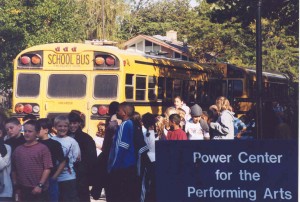 UMS is proud of all of our education programs, but as our K-12 program begins its third decade, I want to take a minute to acknowledge its origins. I’ll never forget my first meeting with Ann Arbor Public Schools arts coordinator Deb Katz in 1988. I wanted her advice about how we might begin a K-12 program. Deb was on maternity leave, so I met with her in her home. As she sat with her infant daughter in her lap, she passed on this clear and authoritative advice: “Start with fourth graders and expose them to opera.” That’s exactly what we did. We engaged the NYC Opera National Company each year well into the 1990s, and as part of their residency, they performed two abbreviated one-hour shows for Ann Arbor fourth graders who were able to experience Carmen, La Bohème, Barber of Seville, and other well-known operas, sung in their original language with English surtitles. Each teacher received a resource packet about the opera and how its elements could be tied to the curriculum – geography, math, language, cultural traditions, etc. Each year the Company invited a dozen students to appear on stage in crowd scenes, complete with costumes. Deb’s advice was right on: Opera had all of the elements – music, dance, and drama – to engage curious, open, and enthusiastic fourth graders.
UMS is proud of all of our education programs, but as our K-12 program begins its third decade, I want to take a minute to acknowledge its origins. I’ll never forget my first meeting with Ann Arbor Public Schools arts coordinator Deb Katz in 1988. I wanted her advice about how we might begin a K-12 program. Deb was on maternity leave, so I met with her in her home. As she sat with her infant daughter in her lap, she passed on this clear and authoritative advice: “Start with fourth graders and expose them to opera.” That’s exactly what we did. We engaged the NYC Opera National Company each year well into the 1990s, and as part of their residency, they performed two abbreviated one-hour shows for Ann Arbor fourth graders who were able to experience Carmen, La Bohème, Barber of Seville, and other well-known operas, sung in their original language with English surtitles. Each teacher received a resource packet about the opera and how its elements could be tied to the curriculum – geography, math, language, cultural traditions, etc. Each year the Company invited a dozen students to appear on stage in crowd scenes, complete with costumes. Deb’s advice was right on: Opera had all of the elements – music, dance, and drama – to engage curious, open, and enthusiastic fourth graders.
Ben Johnson’s arrival in 1995 as our first full-time education director came at the same time UMS was expanding and diversifying our programming. With extraordinary support from the UMS Advisory Committee, who identified our K-12 program as the beneficiary of their Ford Honors Program and On the Road fundraisers and who serve as the volunteer greeters and ushers for all of the youth performances, UMS’s K-12 program now serves up to 20,000 young people from throughout the region who experience the rich diversity of cultural expressions from all over the world.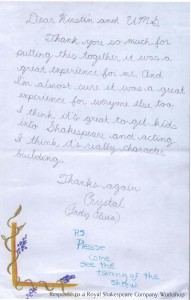
In 1997, UMS was named a “Partner in Education” by the Kennedy Center. Working with the Ann Arbor Public Schools, UMS participates in an annual institute that provides models and planning strategies for expanding professional development programs in the arts for all teachers, as a way of increasing the artistic literacy of young people. In addition to youth performances, we now provide workshops, daylong immersions, and in-classroom experiences that complement the youth performance series in the concert venues.
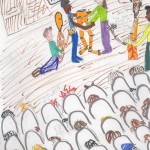 We are so fortunate to live in a community that recognizes the value of arts education. Attendance at teacher workshops and youth performances continues to grow, and we regularly hear that these opportunities have been “game-changers” in the classroom for students and educators alike.
We are so fortunate to live in a community that recognizes the value of arts education. Attendance at teacher workshops and youth performances continues to grow, and we regularly hear that these opportunities have been “game-changers” in the classroom for students and educators alike.
Each year, we host an “After-School Luncheon for Teachers” to talk about the season’s upcoming programs [pdf]. This year’s is tomorrow – Tuesday, September 14 at the Matthaei Botanical Gardens. All are welcome to attend and learn more about UMS’s programs that will help create lifelong lovers of the performing arts.
Program Changes for March
I’m writing with some disappointing news related to the three March Chamber Arts Series concerts. We learned that violinist JULIA FISCHER is canceling her two upcoming UMS concerts, both of which were on the Chamber Arts Series. Because of a family concern, she has canceled her entire US tour. We worked hard to find replacement artists for her two concerts and are delighted to announce that we will be presenting two different artists. The programs will vary from the original all-Bach program given the changes in artist, but we’re very pleased that we’ve been able to work with the artists so that the programs will include significant representation of Bach’s compositions for solo string instruments.
On Wednesday, March 24, Dutch cellist Pieter Wispelwey will perform a solo cello concert that includes two suites by J.S. Bach alongside two suites by Benjamin Britten. 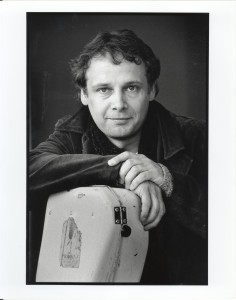
On Thursday, March 25, violinist Jennifer Koh will perform a program that features two of Bach’s partitas, with additional works by Eugène Ysaÿe, Kaija Saariaho, Elliott Carter, and Esa-Pekka Salonen.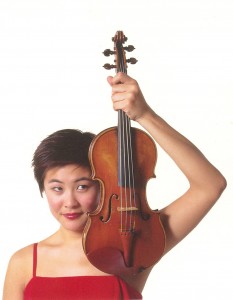
Complete details on each program are included below. Because of the programming changes, the Masterpieces Revealed scheduled for March 23 has also been canceled.
We’ve also heard from the manager of the Takács Quartet who contacted us to let us know that the second violinist, Karoly Schranz, must undergo rotator cuff surgery and will be unable to perform on March 15. The ensemble has re-imagined their program to include duets and trios for violin, viola, and cello by Mozart, Kodály, and Beethoven. Complete details are included below. Mr. Schranz is expected to make a full recovery and looks forward to returning to the Quartet in the fall, and to UMS for three performances of a Schubert cycle during the 10/11 season.
For all three of these concerts, you may use the tickets you were originally issued. You can also return your tickets for UMS credit (which can be applied to another performance in the 09/10 season), or donate your tickets back to UMS for a tax-deductible contribution. Please contact the UMS Ticket Office at 734-764-2538 for complete details.
This has been an unusually difficult year with cancellations and programmatic changes (the Algerian singer Souad Massi canceled her performance in January, and Trio Mediæval their April concert), and we sincerely apologize if you have been impacted by these changes. Whenever we are able to make a substitution and preserve the original integrity and intent of the originally scheduled performance, we make every effort to do so. We hope that you will approach these changes with an enthusiastic spirit of discovery as we introduce two new artists to UMS audiences and different repertory that we don’t often have the opportunity to hear.
As always, we appreciate your support of UMS and hope that you find much pleasure in the new programs.
Members of the Takács Quartet
Edward Dusinberre violin • Geraldine Walther viola • András Fejér cello
Monday, March 15, 8pm
Rackham Auditorium
Program:
- Mozart: Duo for Violin and Viola No. 2 in B-flat Major, K. 424
- Kodály: Duo for Violin and Cello, Op. 7
- Beethoven: String Trio in G Major, Op. 9, No. 1
Pieter Wispelwey, solo cello
Wednesday, March 24, 8pm
Rackham Auditorium
Program:
- J. S. Bach: Suite No. 1 in G Major, BWV 1007
- Britten: Suite No. 1, Op. 72
- J. S. Bach: Suite No. 2 in d minor BWV 1008
- Britten: Suite No. 3, Op. 87
Jennifer Koh, solo violin (no accompanist)
Thursday, March 25, 8 p.m.
Rackham Auditorium
Program
- J. S. Bach: Partita No. 3 in E Major for Unaccompanied Violin, BWV 1006
- Eugène Ysaÿe: Sonata No. 2 in a minor for Unaccompanied Violin, Op. 27, No. 2, “Obsession”
- Kaija Saariaho: Nocturne, in memory of Witold Lutosławski
- Elliott Carter: Fantasy: Remembering Roger
- Esa-Pekka Salonen: Lachen verlernt [with film projection by Tal Rosner]
- J. S. Bach: Partita No. 2 in d minor for Unaccompanied Violin, BWV 1004


